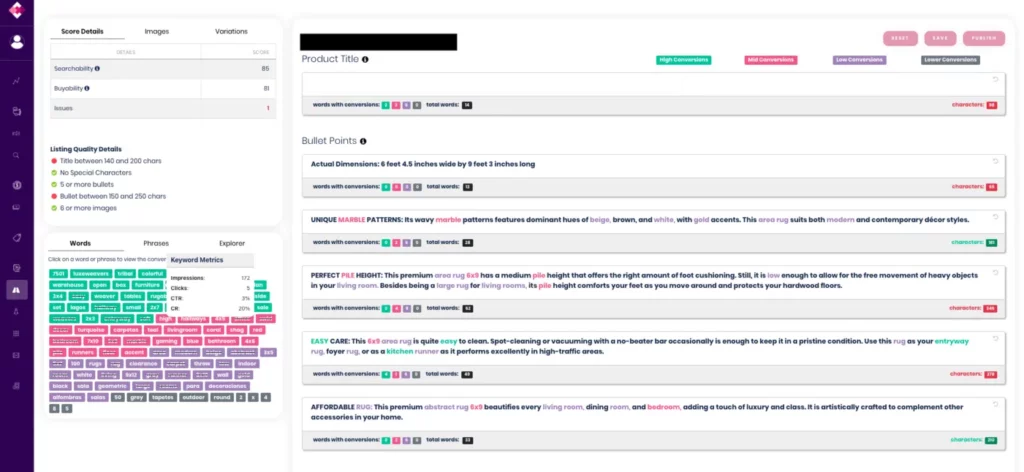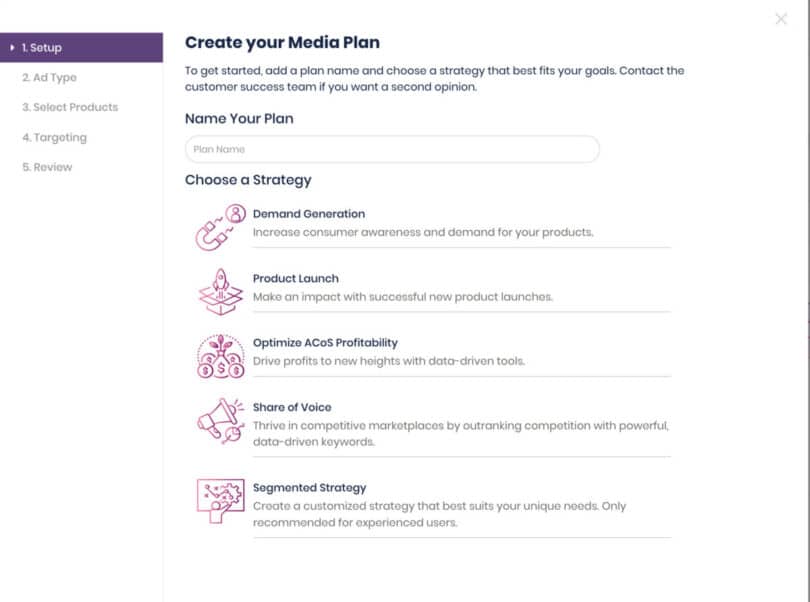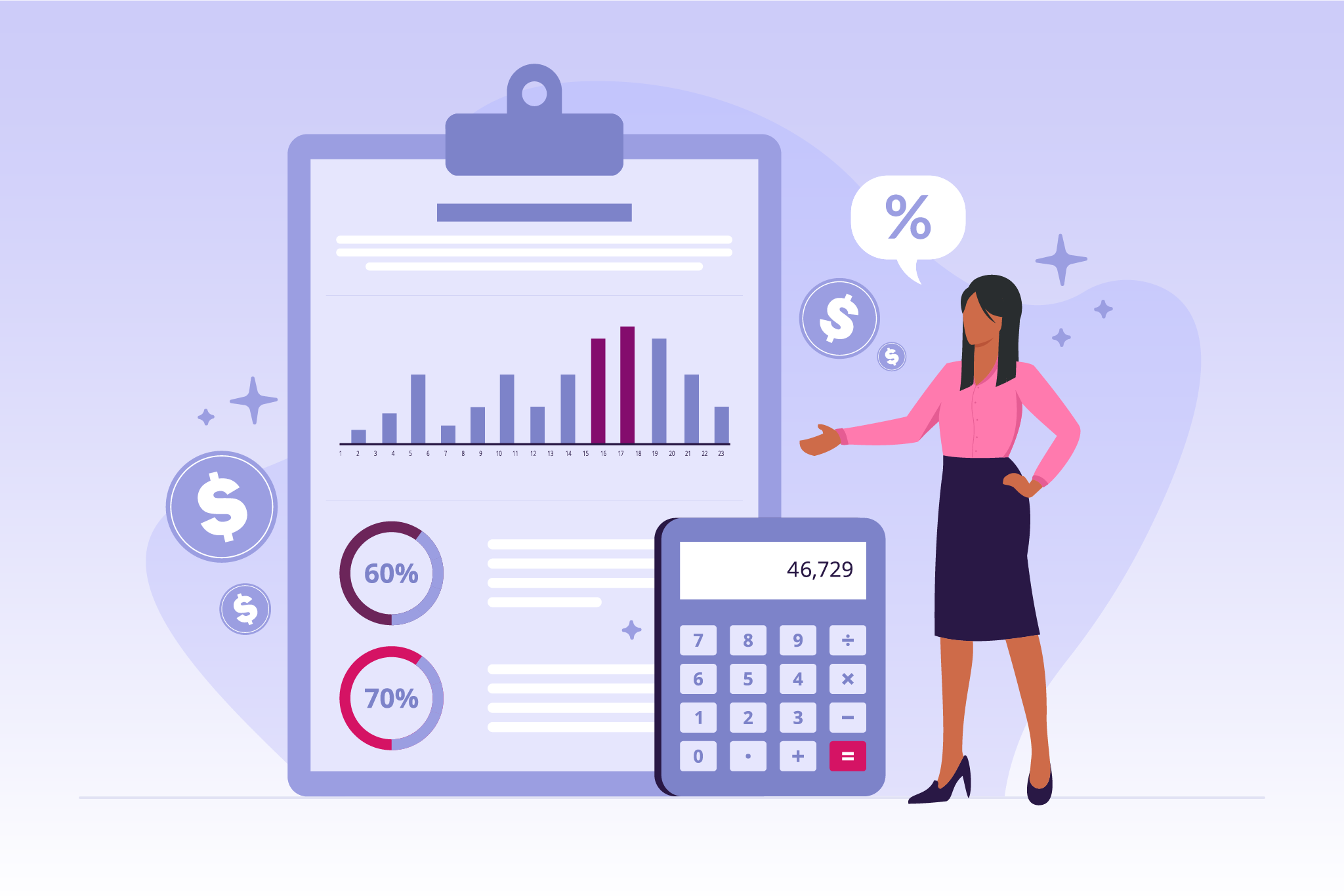Market research, stellar product, beautiful photos, and a detailed listing. You’ve got everything you need for a successful eCommerce venture, right?
Almost everything. Competition is fiercer than ever. It’s not enough to simply prove product/market fit and keep optimizing your listings. If you want to increase profitable sales, you need a smart advertising strategy.
With the right approach, ads can increase sales by as much as 30%. However, that growth won’t matter if your media plan isn’t streamlined and set up for sustainable profitability.
Here are six practical strategies to optimize your media planning and maximize your ROI.
Sponsored ads or DSP? Why not both? Trellis is the self-driving software solution that helps you optimize every campaign. Learn how it works with a free demo.
6 Proven Ad Strategies to Power Up Your Media Plan
A media plan is a detailed strategy that outlines how a seller intends to promote their products on advertising platforms, such as Sponsored Products, Display Ads, and Amazon Demand-side Platform (DSP).
Brands running multi–ad type strategies achieved 1.9× higher ROAS than those relying on a single ad type, thanks to stronger awareness, mid-funnel engagement, and conversion lift.
Your media plan includes your goals, target audience, budget allocation, ad creatives, and performance metrics. And with the right strategies, each element of your media plan can help deliver greater results. Here’s how.
1. Boost Demand Generation
Paid media is about more than sales. If you’ve been focusing your ad dollars at the bottom of the funnel, it could be time to widen your view. Extending your advertising efforts up the funnel to include demand generation is an effective (but often overlooked) way to strengthen your pipeline for long-term success.
To really nail demand gen, you have to understand your audience first. Start by revisiting any brand positioning and buyer persona work you’ve done in the past and think about what’s changed. Without this foundation, you could fall into the trap of wasting budget on audiences that aren’t interested in your products.
Next, focus on growing trust and interest among your target audience. Awareness and demand gen are long-term strategies that can include everything from influencer marketing to social media — and even paid ads.
Here are a few tips to optimize demand gen with your advertising strategy:
- Target precisely. Get the most out of your investment by using focused targeting to reach the right people at the right time.
- Understand Amazon’s promotion options. Deals, discounts, and coupons can all draw attention to your brand.
- Use AI wisely. AI tools can help you test ad placement strategies, as well as optimize campaigns and automate bidding.
- Integrate cross-platform data when possible. Insights from a campaign can inform so many other strategies, including your Shopify ads, search engine optimization (SEO), and more. Look for advertising software that helps you connect the dots between all channels.
In Trellis, integrated data sets unify customer insights across platforms, helping you improve your full-funnel marketing strategies. See for yourself with a free, no-strings-attached demo.
2. Execute Successful Product Launches
Launching a new product can be exciting and stressful. You’ve done the hard work of development — now it’s time to step into the spotlight and turn heads at precisely the right moment.
Thousands of products enter the Amazon ecosystem every day. A well-crafted ad strategy can help you stand out and make your product launch a huge success.
Outshine your competitors with these product launch best practices:
- Optimize product content. Spend the time to flesh out your title, listings, bullets, and descriptions. Use Amazon’s A+ content tool to improve visibility.
- Focus on visual appeal. High-quality images and engaging video ads catch and keep shoppers’ interest.
- Develop a launch strategy. A comprehensive PPC plan is crucial. If you don’t know how to set up campaigns manually (or simply don’t have the bandwidth), you can use Amazon’s auto targeting feature.
- Use sponsored products ads. New products using this ad type see an average increase of 123% in sales.
- Use analytics and testing. Refine your approach with A/B testing to understand every aspect of your campaign.
- Incorporate customer feedback. Don’t forget to ask for post-launch feedback to refine present and future products.
Need help optimizing your pricing? Trellis’s pricing and content optimization tools can help you ensure your new product enters the market with a splash.

3. Optimize ACoS Profitability
When it comes to measuring the profitability of an ad campaign, it doesn’t get more important than ACoS. This metric reveals how much you spend in advertising for every dollar you make. It’s expressed as a percentage, using the following formula:
ACoS = Ad Spend / Ad Revenue X 100
What’s a good ACoS to shoot for? Well, there’s no universally “good” ACoS. In general, a lower ACoS (10-20%) is usually better than a higher one (above 35%). However, to gauge your own profitability, you should look at other sellers in your country, industry, and sub-category who are advertising in the same format as you.
Reducing your ACoS means decreasing your ad bids and/or increasing your conversion rate. Some ways to optimize ACoS are:
- Define your target ACoS. You can use Trellis’s free ACoS calculator to determine breakeven and target points.
- Target the right keywords. Focus on long-tail, low-competition keywords to reach your target audience efficiently.
- Monitor essential metrics. Evaluate early and often — CTR, CPC, and conversion rate will help you flag areas for improvement.
- Take a holistic approach to analytics. ACoS is crucial, but so are other metrics like LTV:CAC and ROAS.
- Experiment with different Amazon campaign types. Test Sponsored Products, Sponsored Brands, and Sponsored Display.
If you’re allergic to spreadsheets, don’t worry — you don’t have to manually calculate these profitability metrics. A data-driven tool like Trellis can help you reduce ACoS and optimize your media plan.
4. Prioritize Share of Voice (SOV)
Maximizing your Amazon Share of Voice (SOV) is a big part of increasing visibility and driving sales. This metric measures your brand’s presence on the first page of search results through paid ads, including sponsored products, brands, and video ads.
Given that more than 70% of Amazon shoppers don’t browse past page one, a strong SOV is crucial to profitability.
Share of Voice is directly related to your ad spend. To calculate SOV, divide the number of your brand’s products by the total number of products on the first page.
SOV = Number of your brand’s products / total number of products
A good eCommerce advertising tool will help you monitor your SOV and see how you stack up to your competitors.
Here are a few strategies to improve SOV:
- Increase ad spend. It’s not rocket science: Higher spend increases visibility. Of course, since most of us don’t have bottomless ad budgets, strategic and efficient spending is key.
- Use dynamic pricing to snag front page real estate and sales.
- Optimize your listings for powerful, data-driven keywords — use our free Amazon keyword research tool.
- Get more reviews with strategies like Amazon Vine, review buttons, product inserts, and promotions.
With Trellis, you can optimize your media plan specifically for SOV. Learn how from Influencer Marketing Hub.

5. Segment Your Audience
A segmented ad strategy helps you reach specific customer groups by targeting based on attributes like age, location, and behavior. This advanced approach lets seasoned advertisers deliver customized ad content to these unique audiences.
Segmenting your ad campaigns creates a personalized experience for the consumer, which impacts engagement and conversion rates. It also helps you spend efficiently by targeting only the most relevant users.
To segment your audience effectively:
- Use Amazon DSP to create, target, and retarget custom audience segments.
- Target 1P audiences using Amazon’s Advertiser Audiences feature.
- Experiment and A/B test different ad formats for different audiences.
- Identify your gateway ASINs and prioritize getting them in front of new audiences with your PPC strategy.
- Incorporate retention strategies for your existing customer segments.
Managing multiple audiences and campaigns can be tricky. Trellis helps you optimize them all with a few clicks while securing the best bidding rates on keywords across your campaigns.
6. Embrace Automation for Efficiency
Artificial intelligence can’t replace human creativity and nuance — but automation can help you increase efficiency and keep your focus on the big picture. Explore how you can use automation tools to handle repetitive tasks and process large amounts of data.
Here are a few areas where AI shines in eCommerce:
- Automated bidding. AI can automatically adjust your bids based on performance metrics and the guardrails you set, ensuring that your ads remain competitive.
- Campaign scheduling. Set your ad campaigns to run during peak times when your audience is most active.
- Dynamic creative optimization. Automated tools can test different ad creative variations and serve the most effective versions to your audience.
- Performance alerts. Set up automated reports and alerts for significant changes in campaign performance, so you can step in and make quick informed decisions.
Automation can run amuck without thoughtful oversight from a strategic seller (that’s you!). Trellis’s advertising features make it easy to set up your campaigns just the way you want them — and then keep an eye on performance.
Turn Ad Strategy into Reality with Trellis
In an increasingly crowded eCommerce market, having a solid paid media plan is essential. These six advertising strategies can help you establish your presence, optimize your investment, and drive sustainable, profitable growth.Manage the 4Ps of profitability in one place with Trellis’s comprehensive suite of tools — from automated bidding to dynamic pricing and product listing SEO. To see these strategies in action, schedule a demo with Trellis today and unlock your brand’s potential.
In Summary
Media planning means coordinating your Amazon ad types—Sponsored Products, Sponsored Brands, Sponsored Display, and DSP—so they work together across the customer journey. A balanced budget typically looks like: 40% Sponsored Products, 30% Sponsored Brands, 20% Sponsored Display, and 10% DSP. This mix builds awareness, drives consideration, and captures conversions while keeping ROAS stable across your funnel.
Optimize your Amazon ad mix with Trellis: Our Strategic Management platform automatically adjusts budgets across Sponsored Products, Brands, Display, and DSP to maximize blended ROAS.






